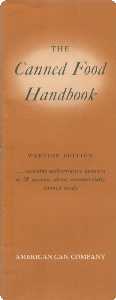Canned Foods and the Wartime Consumer
 The Canned Food Handbook (26 pages) was published during World War II by the American Can Company to educate consumers about commercially canned foods. This special Wartime Edition also addressed some of the issues that people faced regarding their food supply during the war.
The Canned Food Handbook (26 pages) was published during World War II by the American Can Company to educate consumers about commercially canned foods. This special Wartime Edition also addressed some of the issues that people faced regarding their food supply during the war.One purpose of the booklet was to clear up some of the common misconceptions about canned foods that were prevalent at the time. Presented in a Q&A format, many of the items covered concerned food safety and the nutritional value of canned foods in general.
For example, many women were firm in their belief that canned foods should be emptied into another container as quickly as possible after the container was opened so as to avoid harmful health effects. This belief was brought on in part by the earlier labeling practices that recommended one do so. Although in reality, manufacturers were more concerned about the attractive appearance of their product after the can was opened, many consumers received the message that the food became unsafe if it wasn't immediately transferred into a different container. The booklet tries to rectify this confusion by stating that it was okay to leave the food in the cans after opening as long as they were kept cool and covered.
As was also common during this time period, manufacturers, in their quest to educate consumers so they would be more comfortable with the idea of processed foods, used scientific evidence and references to government offices to infer that their food processing practices met with the highest standards. This booklet has the Seal of Acceptance from the Council on Foods and Nutrition of the American Medical Association.
The booklet contains 38 queries in all, grouped into the four sections of General, Nutrition, Public Health Aspects, and Purchase and Use. A sampling of the questions included is:
- What is enameled steel?
- Do canneries use the so-called surplus crops?
- Are cooked fruits and vegetables prepared from market more nutritious than similar canned varieties?
- Are canned foods suitable for children?
- Are preservatives used in canned foods?
- Does rust on a can indicate spoilage?
- What is the liquid in the can?
- Should foods be heated in the can?
"Enameled steel is a special material developed during the past three years for making containers for a wide variety of essential products, including certain foods. Wherever possible, the use of enameled steel in food containers is now required by the WAR PRODUCTION BOARD as one means of conserving tin."
Canned foods represented only one of the many shortages on the home front during World War II. The rear of the booklet contains a four-page List of Canned Foods that existed before the war. The War Production Board, however, restricted or prohibited production of certain items for civilian use in order to conserve metal, so the individual food items are marked with symbols that showed the foods to be classified in one of four ways:
- Production Prohibited
- Entire Production Scheduled for Government Purchases
- Production Limited
- Production Unlimited
You can find out that the production of canned crabapples, beets, catsup, grapefruit and orange juice, were just a few of the things whose production was scheduled for purchase by the government.
There are several black and white illustrations interspersed throughout the text. There are also two pages of literature references at the end of the booklet.

0 Comments:
Post a Comment
<< Home